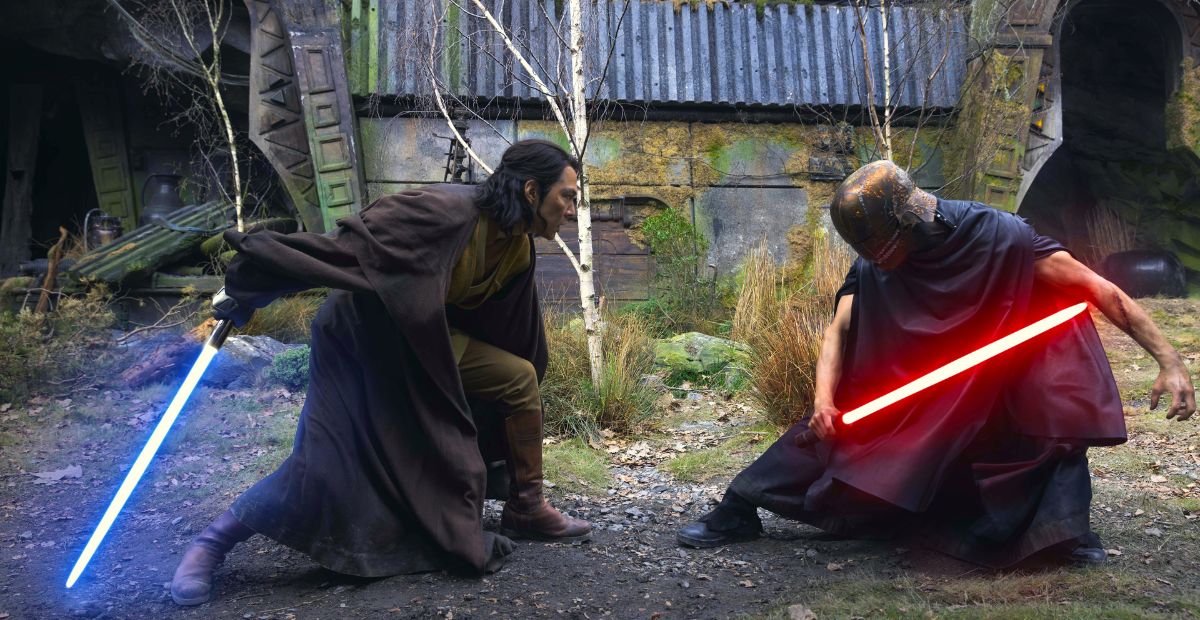The Acolyte drew criticism for its creative choices and budget and was ultimately canceled.
Yet, this Disney+ show also broke new ground and pushed Star Wars in a different direction. Despite debates over the show, we can recognize its merits.
Here are the 10 best things about The Acolyte.
1. Lightsaber Action
One review of The Acolyte lists the lightsaber action as a top item. The lightsaber fights in this series could be “the best” since The Phantom Menace.
This scene here gives us a sense of how the show succeeded with this crucial aspect of Star Wars. The maneuvering with dual lightsabers and battle action was superb.
2. The High Republic
The Acolyte took place in the High Republic, exposing a time not previously covered on screen. The show brought us back to the height of the Galactic Republic and an age when the Jedi ensured peace. A Pax Star Warsica, we might say.
The Acolyte also corresponded with comics and books about the era and thus ushered in a new period to new audiences.
3. Mae and Osha
By centering on the twin sisters, Mae and Osha, the Acolyte was original. These characters and “how they [were] impacted by both the Jedi and the dark side” could arguably be “the best parts of the Acolyte.”
At the heart of the show’s mystery premise, the twins, especially Mae, provided the intrigue and allure.
Amandla Stenberg played both of these characters, reflecting her acting range and giving life to the central players in the story.
Her preparation for the role included stunt choreography and martial arts training, along with a focus on subtle shifts in “mannerisms” “to embody Mae and Osha.”
4. The Character of Sol
Lee Jung-Jae likewise gave a strong performance in the role of Sol. This character was respected as a “wise” and “compassionate” Jedi but also had secrets of his own.
The complexity of the character gave a boost to the Acolyte. His blend of honor and tragedy provided an anchor to the storyline.
The twist in the end, with Sol mistaking the intent of Mother Aniseya and killing her, provided more depth to the character. Sol’s character also set up deep questioning of the Jedi and their ways.
5. The Nature of the Jedi
This article posits that the most interesting element could be how The Acolyte explored “the Jedi’s authoritarian nature.”
In this series, the Jedi can come off as overbearing and controlling with their “autocratic beliefs on who gets to use the Force and who doesn’t,” along with how they “take children from their families, never to be seen again.”
As with the above scene with Sol, and the one where he decided to let Mae presumably perish, the show reveals a rather shady underbelly to the Jedi that is not necessarily pure and good.
That can be seen in Sol’s actions and his determination to bring Mae into the fold of the Jedi, at all costs.
6. The Stranger/Qimir
The introduction of a new villain who does not always seem like a villain was also a highlight of the show.
The Stranger or Qimir is thought to be a Sith by the end of the series, but it’s still not entirely clear. He was trained by the Sith but he proceeds on his own path.
Likewise, fans here liked Manny Jacinto in the role of Qimir, and how “his levity in the character really [sold] the ‘Sith’ aspect,” especially how this Sith projected a “lightheartedness while slaughtering Jedi.”
The Stranger levitated between light and darkness, which helped boost the show.
7. The Death of Jedi
Fans from the above discussion also appreciated how The Acolyte did not shy away from having Jedi die in the show.
We may have thought that the series was “gonna softball the deaths,” but in Episode 5, Jedi deaths came forth.
We saw The Stranger battling the Jedi in this pivotal scene, revealing his powers and the vulnerability of the Jedi.
8. The Use of Cortosis
In the above battle scene, we also saw how Jedi lightsabers temporarily shorted out. That was due to the rare metal cortosis that Qimir used in his helmet and wrist gauntlets. When Osha puts the helmet on in Episode 6, we get a foreboding sense of its power.
Cortosis derives from Legends, and The Acolyte brought it forth for canon audiences.
9. Entrance of Darth Plagueis
On a similar note, The Acolyte briefly showed us a glimpse of Darth Plagueis. Plagueis was the dark Sith lord behind the rise of Palpatine who almost cheated death.
His power is mysterious and perhaps beyond that of the Emperor. That the Acolyte went in this direction showed a willingness to draw on the depths of Star Wars.
10. New Stories and Characters
Although the show stirred debate and was canceled, The Acolyte introduced both new characters and new stories that helped broaden Star Wars.
As this article conveys, Leslye Headland was “willing and able to challenge the core tenets” of the franchise.
Whether viewers loved or hated it, the series did present new angles for the galaxy and premises upon which to build, including neat divisions between Jedi and Sith.

